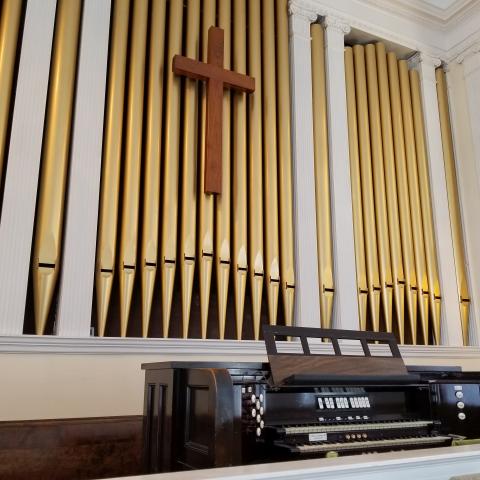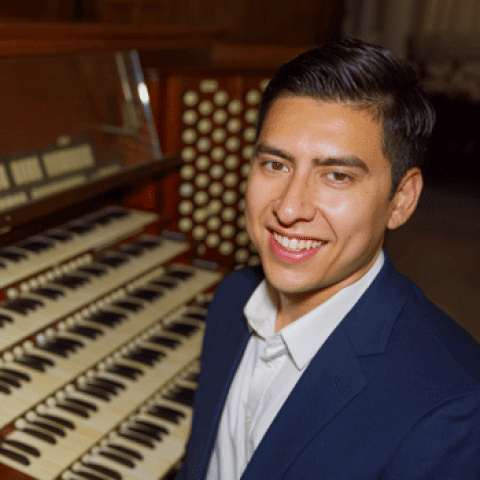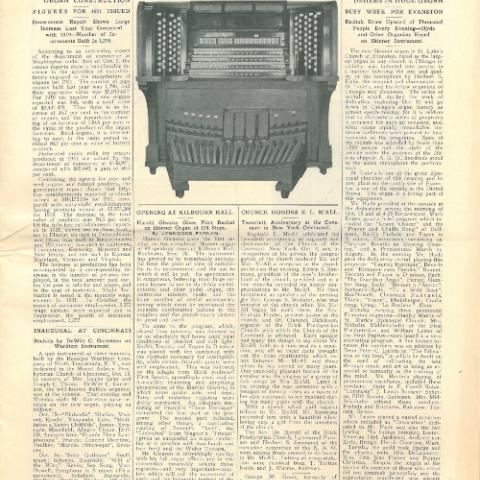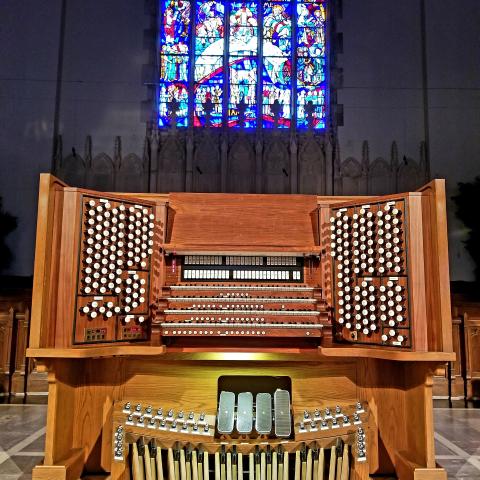Foley-Baker, Inc., Tolland, Connecticut;
Holy Cross Catholic Church, New York, New York
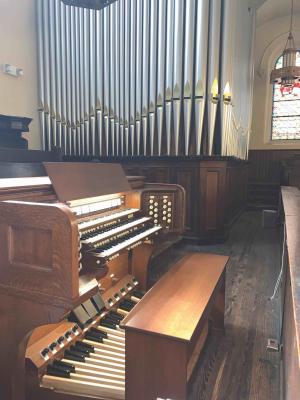
The saga of Aeolian-Skinner Opus 908
This is a special organ. It was built at a special time and for installation in a special city. Most know the story: by the 1930s Ernest Skinner had sold his firm (1919) to Arthur Hudson Marks, businessman and organ enthusiast. It was a move that saved the company but also paved the way for new blood and new ideas. G. Donald Harrison was just such a paragon and at first (1927) a near soulmate of Skinner’s. However, when the organ-buying world began taking note of Harrison’s new and different tonal approach, Skinner took umbrage, and by 1932, and despite an active employment agreement with Marks, he walked out. Harrison was free to do his own thing, and Opus 908, a three-manual, twenty-nine-rank organ, was a good example.
The reviewer for the organ’s opening in December of 1933 was none other than William H. Barnes, whose notes in The American Organist clearly stated that the instrument’s design was so advanced and good for a small organ, that “This will stand out as a fine musical instrument through the years, in spite of fads or fancies, or swings of the (tonal) pendulum. It is my contention that the best all-around service will be obtained from an organ of this character . . . . It will always be a musical instrument pleasing to musicians.”
Few listened more closely back in those days and, frankly, Barnes’s take on things was spot on. As a relatively small organ, the Harrison-Skinner specification and voicing made Opus 908 a winner—especially in such welcoming acoustics. Unlike so many other organs of this era, Opus 908 is as marvelously musical in the twenty-first century as it was in the early twentieth.
Ten years ago, things weren’t so great for this organ. Holy Cross was ramping up to start a massive redecorating project. At the last minute, the contractors decided that the organ had to be removed. Luckily, we had the time and resources. The fact that all this organ equipment had to be temporarily trucked away inspired hopes that while it was at our shops, it could also be reconditioned, something it badly needed. But that did not happen. Plain and simple, despite some good effort and pleas, the building renovation project instead usurped all available funding. In fact, it went over budget to the point that there was then no money to bring the organ back to the church. Despite our recommendation that it be warehoused, we were asked to move it to the least costly storage location—a container. Words were laced with hopes that somehow money would soon be found to recondition the instrument. Adding to all the anxiety, a change in hierarchy at Holy Cross saw interest in the organ plummet. Could its renovation costs possibly cause the church to sell the organ? By this time, only the organist, Charles Currin, and a few involved parishioners remained to lament what was not happening with the Skinner.
Weeks turned to months, and months turned to years. Changes in pastors and organists (a used electronic had been purchased) saw Opus 908 all but disappear from memory, let alone anyone’s focus. That is, until Father Tom Franks came on board. It was nearly eight years later when my phone showed the incoming call from area code 212. Father Franks was the new pastor—and he had interest. Emails were exchanged, and although he could not find money yet, the organ could at least feel the stirrings of its heritage calling—somebody at the top cared!
About six months later the magic call arrived: Father Franks proclaimed that the church was selling a tiny nearby building, and it looked like the money would cover the organ’s total reconditioning and reinstallation. You can only imagine the relief we and some at the church felt. You can bet Opus 908 had a smile on its face.
Its very rusted face, that is, because when we removed its hundreds of components from what was to have been short-term storage, we found that more than the original water damage was now visible. (Why is it that leaking roofs are so often over pipe organs?) Most everything was salvageable, but the work effort to restore this once fine instrument had nearly doubled. By now, so many of us, including Tom DeFrancesco, the church’s new and very interested organist, felt a personal attachment. Opus 908 had to rise again.
Adding further suspense, Father Franks had signed the contract on his way to his new parish. Would Holy Cross’s next pastor have any interest? He sure did. Read on . . . .
Father Francis Gasparik arrived at Holy Cross and all too soon became aware of the many needs of the 150-year-old building—the oldest structure on Manhattan’s 42nd Street. Needless to say, with such an old building, many of its needs reflected industrial-strength issues that all came with industrial-strength repair costs. But instead, he heard of the money being spent on reviving the old organ. Understandably, it took a while for Father Gasparik to digest the situation, learn about organs, and develop an appreciation for the Aeolian-Skinner. I think the day the 128 restored façade pipes were reinstalled was one of great change and appreciation by everyone involved. The reinstalled organ made Christmas of 2019 very special.
Our reconditioning work included replacement of every piece of leather, scrubbing and clear coating of every (now very seasoned) piece of wood, plus a pipe washing and voicing process far more time consuming than we’ve ever before encountered. Even the Spencer Turbine blower and its motor were refurbished. All reed stops were reconditioned by Broome and Company. The very tired eighty-year-old console was given every nuance of attention. It is now as comfortable and beautiful as the photos here indicate.
In my fifty-plus years in the organ business, no FBI job has approached the challenges that came with Opus 908. But, now it’s over. The church is delighted; the organ looks, sounds, and works wonderfully. The years, problems, and costs will pass into history, but this special Aeolian-Skinner will live on. The old adage is true: All’s well that ends well.
—Mike Foley, President, Foley-Baker, Inc.
Aeolian-Skinner Opus 908/Foley-Baker, Inc.
GREAT ORGAN (Manual II)
16′ Flute Conique (Gemshorn)* 12
8′ Diapason 61
8′ Flute Harmonic 61
8′ Gemshorn 61
4′ Principal 61
2-2⁄3′ Grave Mixture II 122
8′ Trumpet (Sw)
Chimes (Ch)
SWELL ORGAN (Manual III, enclosed)
8′ Geigen Diapason 73
8′ Rohrflöte 73
8′ Salicional 73
8′ Voix Celeste 73
8′ Aeoline 73
4′ Flute Triangulaire 73
2′ Mixture IV 244
16′ Waldhorn ** 73
8′ Trumpet 73
8′ Corno d’Amour 73
8′ Vox Humana 73
4′ Clarion 73
Tremulant
CHOIR ORGAN (Manual I, enclosed)
8′ Viola 73
8′ Concert Flute 73
8′ Kleine Erzähler 73
8′ Kleine Erzähler Celeste 61
4′ Flute d’Amour 73
8′ Clarinet 73
Tremulant
Chimes
PEDAL ORGAN
32′ Resultant
16′ Diapason 32
16′ Bourdon 32
16′ Gemshorn (Gt)
8′ Octave 12
8′ Flute 12
8′ Rohrflöte (Sw)
16′ Waldhorn (Sw)
8′ Trumpet (Sw)
* Original factory knob name
** Spec’d in 1933; built/installed in 2019
COUPLERS
Swell to Pedal
Great to Pedal
Choir to Pedal
Swell to Pedal 4
Choir to Pedal 4
Pedal to Choir
Swell to Great
Choir to Great
Swell to Choir
Swell 16
Swell 4
Swell to Great 16
Swell to Great 4
Swell to Choir 16
Swell to Choir 4
Choir 16
Choir 4
Choir to Great 16
Choir to Great 4
Great 4
Swell Unison
Great Unison
Choir Unison
Manual Transfer
All Pistons Next
29 ranks, 25 stops, 1,927 pipes
Builder’s website: http://foleybaker.com
Church website: https://christinthecity.nyc
photo by Tom DeFrancesco

